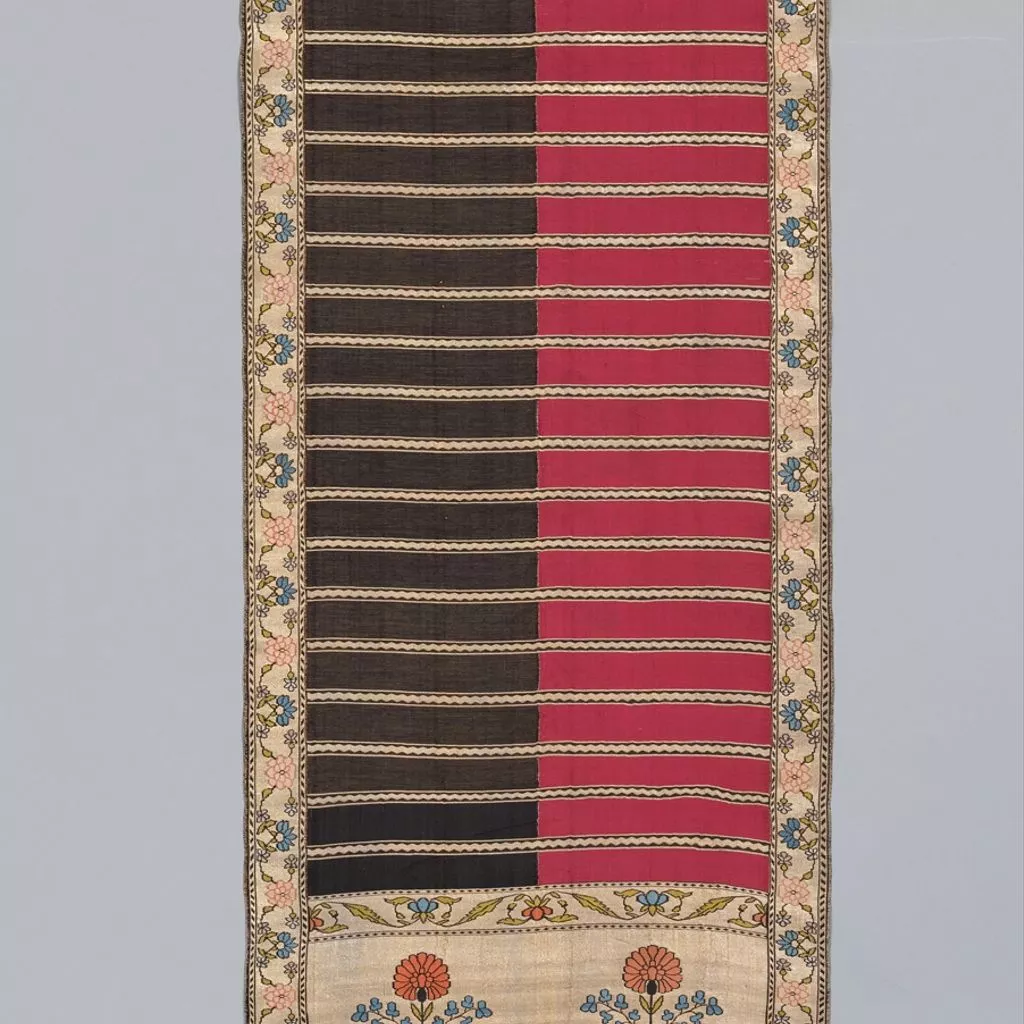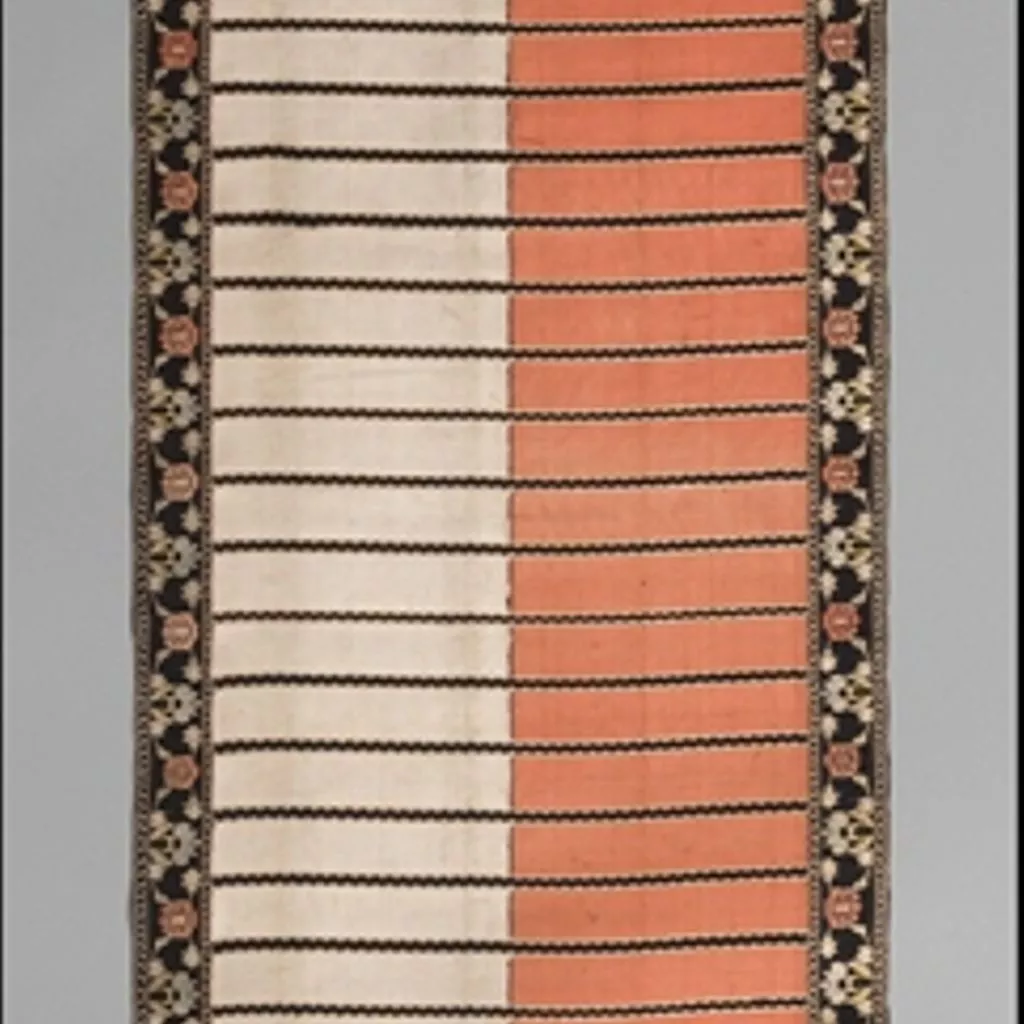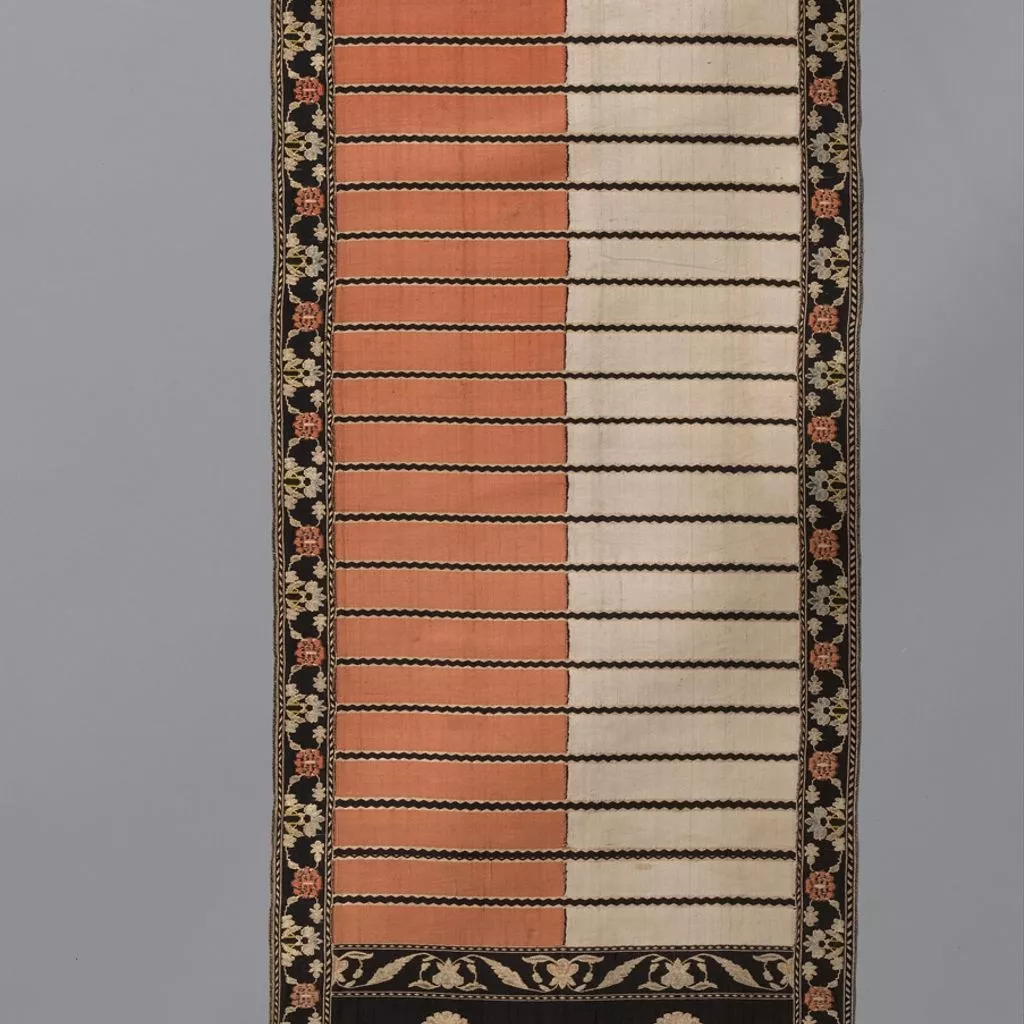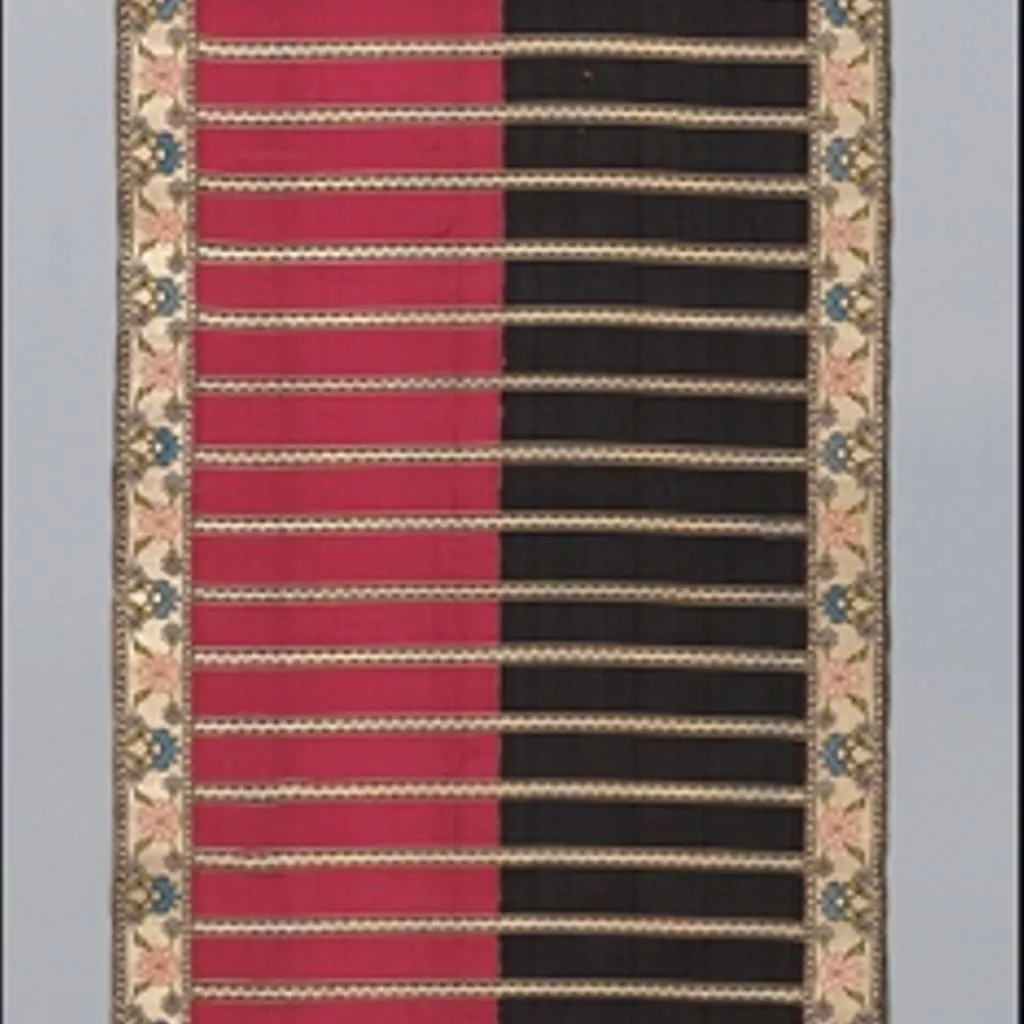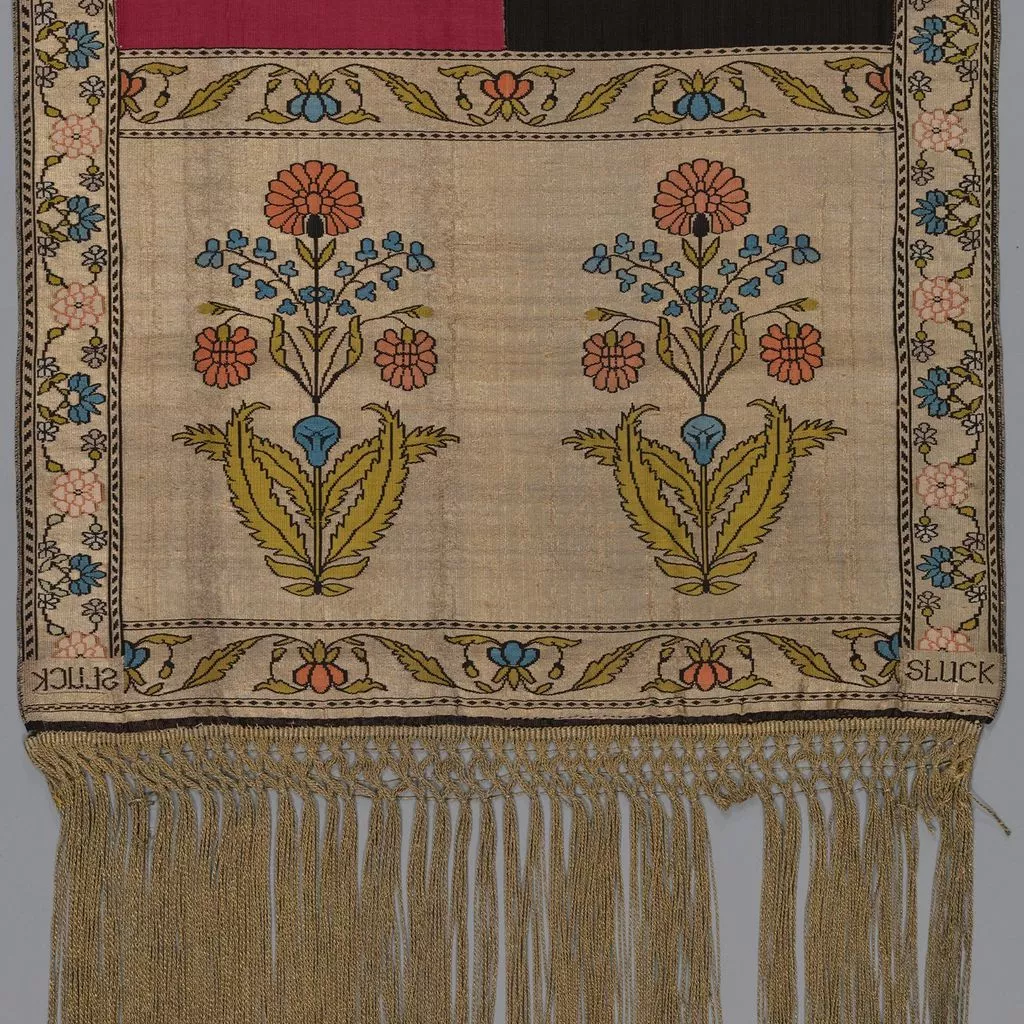Description
A study of paintings from Iran indicates that in the early sixteenth century the typical waist girdle was a leather strap with metal plaques, which then gave way to a narrow textile band with gold fasteners.¹ By the seventeenth century, a long and wide sash wrapped and knotted around the waist was customary.² These sashes had a central field of narrow stripes with decorative panels of flowering plants at either end; they were tied so that these floral panels were visible. The sash was an indispensable accessory and a tool for projecting the status of the wearer. Thomas Herbert, part of an English embassy to Iran in the late 1620s, remarked on both the length of these sashes and the meaningful variation in their materials: "Their waists are girt with fine towels [a plain fabric band worn under the sash] of silk and gold about 8 yards long; those and the sashes distinguish the quality of those that wear them; dukes and other of the noble sort have them woven with gold, merchants and qezelbash with silver; of silk and wool those of inferior rank."³ By this measure, an Iranian sash in the Museum's collection (see MMA 33.80.18), with its gold ground extending the whole of its almost fourteen-foot length, must have been worn by a rich and important personage.⁴ A further mark of its quality is the fact that the back of the sash is well finished. Similar sashes were also worn in the Ottoman and Mughal realms on either side of the Safavid cultural sphere. By the late seventeenth century this fashion had spread to parts of eastern Europe such as Poland and Russia, where textiles imported from Iran and Turkey had become status symbols worn by courtiers. Persian sashes became a requisite part of the wardrobe for noblemen of the Polish-Lithuanian Commonwealth, at the crossroads between the Ottoman Empire, the Russian Empire, and the European Holy Roman Empire. The aristocracy’s entire style of dress was influenced by fashions from the Safavid and Ottoman courts, but the sash retained its popularity long after other features became more Westernized. By the eighteenth century the demand for silk sashes, or kontusz (and thus known as kontusz sashes) worn over an outer coat, became so great in Poland that domestic manufactories, called persiarnie, were established.⁵ One of the finest eighteenth-century producers was the establishment founded in the city of Sluck, east of Warsaw, by an Armenian named Jan Madjarski and his son Leo⁶ The Madjarskis clearly took great pride in their work and "signed" their sashes with woven inscriptions on the end panels (as in this example), where they were certain to be seen. These sashes were normally worn folded in half lengthwise and then wound around the waist. An innovation introduced by the Polish manufacturers was the production of a two-color, double-sided main field that enabled the wearer to extend his wardrobe by folding and tying his sash up to four different ways.⁷From the mid-seventeenth century European observers used the word shawl, derived from the Persian sha¯l, to describe the oblong textiles woven of very fine wool that were used by Iranian men as waist sashes and by Indian men as shoulder coverings. By the late eighteenth century the white "Kashmir" shawls with colorful pinecone or paisley motifs at each end became the de rigueur fashion accessory for European women (for an unusual and creative use of a shawl as headgear, see MMA 45.59.3). An early reference to shawls imported to England from the Kashmir region appears in 1767, in the correspondence of British author Laurence Sterne.⁸ French Empress Josephine is often credited with popularizing the trend at the turn of the nineteenth century and is said to have owned more than fifty expensive imported shawls. During the early nineteenth century Kashmiri shawl makers began to replace the plain white field of these textiles with bold colors or stripes. At the same time, Europeans started weaving shawls in an attempt to meet the increased demand for the fashionable accessories. Traditional Kashmir shawls were patterned using a twill tapestry technique, which was extremely time consuming. Driven to make shawls more quickly, European makers normally employed faster weaving techniques, but a few Russian makers retained the tapestry method.⁹ Several of the Russian workshops were run by female members of the landed gentry, who took advantage of the inexpensive serf labor available to them to produce these amazingly fine textiles (see MMA 65.91.1)¹⁰ In that example, the flowers in the pinecone shapes at each end of the shawl can be identified as European species such as poppies, roses, and cornflowers; there even appears to be a type of tuber vegetable anchoring the individual motifs. The vivid stripes of that shawl may have been inspired in part by the colorful men’s sashes being produced in Poland, Russia, and France, which themselves had been inspired by Iranian and Indian precursors. [Melinda Watt, adapted from Interwoven Globe, The Worldwide Textile Trade, 1500-1800/ edited by Amelia Peck; New York: Metropolitan Museum of Art; New Haven: distributed by Yale University Press, 2013]1. Goetz, "The History of Persian Costume," p. 2247. 2. Scarce, "Vesture and Dress: Fashion, Function, and Impact," pp. 36, 42. 3. Herbert, Travels in Persia, 1627–1629, p. 232. 4. Sir Jean Chardin, writing in the 1660s, noted the large costs incurred by courtiers to maintain their wardrobes. Quoted in Floor, "Economy and Society: Fibers, Fabrics, Factories," p. 22. 5. Poskrobko-Strze˛ciwilk, "Polish Kontusz Sashes in the Collection of The Metropolitan Museum of Art," pp. 19, 23. I am grateful to Ms. Poskrobko-Strze˛ciwilk for her generosity in sharing her time to discuss this research. 6. Ibid., p. 24. 7. Ibid., p. 32. 8. See Irwin, The Kashmir Shawl, p. 19. 9. Catalogue number 101C is composed of twill-woven solid-color stripes and tapestry-woven patterned areas; these components were woven separately and then skillfully joined. 10. The two most prominent female-owned manufactories in Russia were those of Nadezhda Merlina (active in Nizhny Novgorod, 1806–34) and Vera Andreevna Eliseeva; see Cooper, "Luxury Textiles from Feudal Workshops: 19th Century Russian Tapestry-Woven Shawls," pp. 224–35. For a shawl signed by the Merlina workshop (very similar to cat. 101C), see Metropolitan Museum, acc. no. 1972.175.





